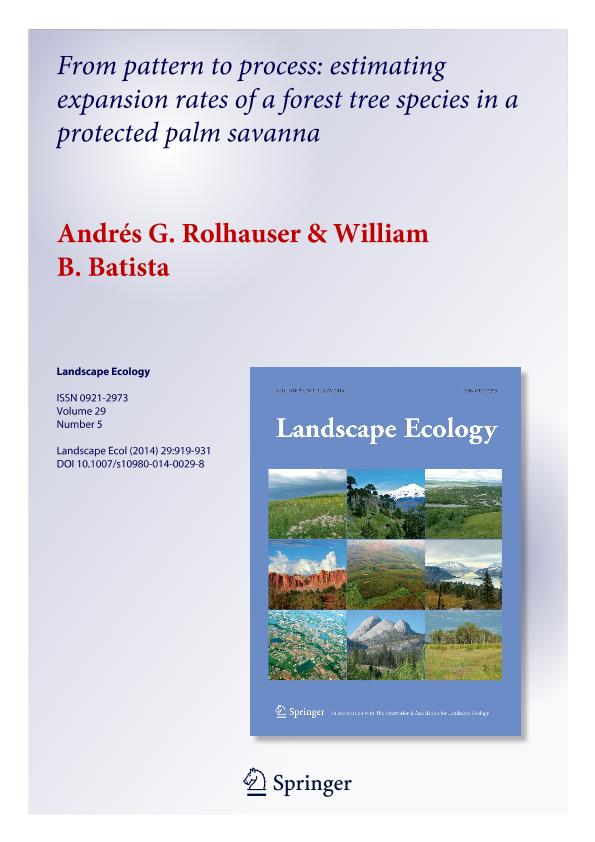Mostrar el registro sencillo del ítem
dc.contributor.author
Rolhauser, Andrés Guillermo

dc.contributor.author
Batista, William B.

dc.date.available
2018-01-18T21:01:02Z
dc.date.issued
2014-04
dc.identifier.citation
Rolhauser, Andrés Guillermo; Batista, William B.; From pattern to process: estimating expansion rates of a forest tree species in a protected palm savanna; Springer; Landscape Ecology; 29; 5; 4-2014; 919-931
dc.identifier.issn
0921-2973
dc.identifier.uri
http://hdl.handle.net/11336/33895
dc.description.abstract
We assessed the possible influences of dominant tree density (Butia yatay palm trees) and fire on the expansion of a riparian tree population (Myrcianthes cisplatensis) over El Palmar National Park, a protected savanna in Argentina. Our approach is based on Skellam´s model of population expansion, which predicts that populations with density-independent reproduction and random dispersal will exhibit Gaussian-shaped expansion fronts. Using Poisson regression, we fitted Gaussian curves to Myrcianthes density data collected at varying distances from a riparian forest, within four environmental conditions resulting from combinations of palm density (dense and sparse) and fire history (burned and unburned). Based on the estimated parameters, we derived statistics appropriate to compare attained expansion velocity, mean squared effective dispersal distance, and density-independent population growth among environmental conditions. We also analyzed the effects of palm density, fire history, and distance from the riparian forest on local maximum size of Myrcianthes individuals. Gaussian curves fitted the data reasonably well and slightly better than two alternative front models. Palm density and fire history interacted to control Myrcianthes spread, making unburned dense palm savannas the preferential avenue for Myrcianthes population expansion across the landscape. Limitation of Myrcianthes expansion by fire appeared to result from low survival of small individuals to fire, whereas facilitation of Myrcianthes expansion by palm trees may have resulted from increased population growth. Our results stress the interactive role of fire regime and local biotic influences in determining propagule pressure and tree establishment at the forefront, and the overall vulnerability of savannas to colonization by forest species.
dc.format
application/pdf
dc.language.iso
eng
dc.publisher
Springer

dc.rights
info:eu-repo/semantics/openAccess
dc.rights.uri
https://creativecommons.org/licenses/by-nc-sa/2.5/ar/
dc.subject
Grassland-Forest Boundary
dc.subject
Invasibility
dc.subject
Inverse Modeling
dc.subject
Population Expansion
dc.subject
Propagule Pressure
dc.subject
Skellams Model
dc.subject
Spread Rate
dc.subject
Woody Encroachment
dc.subject.classification
Otras Ciencias Biológicas

dc.subject.classification
Ciencias Biológicas

dc.subject.classification
CIENCIAS NATURALES Y EXACTAS

dc.title
From pattern to process: estimating expansion rates of a forest tree species in a protected palm savanna
dc.type
info:eu-repo/semantics/article
dc.type
info:ar-repo/semantics/artículo
dc.type
info:eu-repo/semantics/publishedVersion
dc.date.updated
2018-01-16T18:23:54Z
dc.identifier.eissn
1572-9761
dc.journal.volume
29
dc.journal.number
5
dc.journal.pagination
919-931
dc.journal.pais
Países Bajos

dc.journal.ciudad
Dordrecht
dc.description.fil
Fil: Rolhauser, Andrés Guillermo. Universidad Nacional de San Juan. Facultad de Ciencias Exactas Físicas y Naturales. Departamento de Biología; Argentina. Universidad de Buenos Aires. Facultad de Agronomía. Departamento de Métodos Cuantitativos y Sistemas de Información; Argentina. Consejo Nacional de Investigaciones Científicas y Técnicas. Oficina de Coordinación Administrativa Parque Centenario. Instituto de Investigaciones Fisiológicas y Ecológicas Vinculadas a la Agricultura. Universidad de Buenos Aires. Facultad de Agronomía. Instituto de Investigaciones Fisiológicas y Ecológicas Vinculadas a la Agricultura; Argentina
dc.description.fil
Fil: Batista, William B.. Consejo Nacional de Investigaciones Científicas y Técnicas. Oficina de Coordinación Administrativa Parque Centenario. Instituto de Investigaciones Fisiológicas y Ecológicas Vinculadas a la Agricultura. Universidad de Buenos Aires. Facultad de Agronomía. Instituto de Investigaciones Fisiológicas y Ecológicas Vinculadas a la Agricultura; Argentina. Universidad de Buenos Aires. Facultad de Agronomía. Departamento de Métodos Cuantitativos y Sistemas de Información; Argentina
dc.journal.title
Landscape Ecology

dc.relation.alternativeid
info:eu-repo/semantics/altIdentifier/url/https://link.springer.com/article/10.1007%2Fs10980-014-0029-8
dc.relation.alternativeid
info:eu-repo/semantics/altIdentifier/doi/http://dx.doi.org/10.1007/s10980-014-0029-8
Archivos asociados
